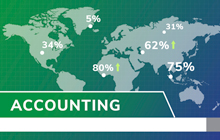The Corporate Piggy Bank: Accessing corporate cash through use of short-term specific purposes loans

Gergely Hegedus and Keith Hennel of Dentons on short-term corporate loans during the current COVID-19 pandemic
 |
Gergely Hegedus (left) is a senior associate in the Tax Group in Edmonton at Dentons Canada LLP. Keith Hennel (right) is a partner at Dentons Canada LLP and serves as chair of Dentons’ Edmonton Tax group. |
EDMONTON – Accessing cash may be challenging during the economic downturn in Canada precipitated by the COVID-19 pandemic. Shareholders who are individuals, and employees, may wish to access cash through loans from a corporation that they own or of which they are an employee. These loans are generally included in the income of the borrower in the year in which the loan was received pursuant to subsection 15(2) of the Income Tax Act (Canada) (the “ITA”) unless certain exceptions are met. This article discusses how individual shareholders and employees of a Canadian corporation may arrange corporate loans without having to include them in income.
Short-term loans
Loans by corporations to their individual shareholders or employees that are repaid within one year after the end of the taxation year of the corporate lender in which the loan was made are not included in the income of the borrower pursuant to subsection 15(2.6) of the ITA.
For example, if a shareholder receives a loan on June 1, 2020 from a corporation that has a year-end October 31, then the loan must be repaid by October 31, 2021 otherwise the loan will be included in the shareholder’s income for the 2020 taxation year. If, however, the shareholder repays the loan by October 31, 2021, then the amount of the loan will not be included in the shareholder’s income.
Series of loans or other transactions and repayments
It is important to note that the repayment of the loan must not be part of a series of loans or other transactions and repayments for the loan not to be include in income. For example, when a repayment is of a temporary nature, such as a loan that is repaid shortly before the end of the year and the same amount, or substantially the same amount is borrowed shortly after the end of the year, then this arrangement will not qualify for the exception under subsection 15(2.6) of the ITA and will be included in the income of the borrower.
Bona fide repayments of shareholder or employee loans that result from, for example, the payment of dividends, salaries, or bonuses, are not part of a series of loans or other transactions and repayments.
Forgiven amounts
When a loan or other obligation of a shareholder to a corporation is settled or extinguished by payment of less than the amount of the obligation outstanding, or by no payment, the value of the benefit is to be included in the borrower's income under subsection 15(1) of the ITA for shareholders and subsection 6(15) of the ITA for employees in certain cases. To the extent that the forgiven amount is included in income as a shareholder or employee benefit, the debt forgiveness rules in section 80 of the ITA should not apply.
Deduction of repayment
When a borrower has repaid all or part of a loan that was included in income in a preceding year under subsection 15(2) of the ITA, the amount of the repayment is deductible under paragraph 20(1)(j) of the ITA in calculating income for the year in which the repayment is made. This ensures that amounts included into income are subject to an offsetting deduction on repayment. However, no deduction is allowed if the repayment is made as a part of a series of loans or other transactions and repayments.
Evidence of loans
While the Canada Revenue Agency has indicated that a written agreement is not necessary to establish that a loan exists, it is preferable to have a written agreement supporting the existence of a loan. Corporate resolutions authorizing the loan and setting out the terms of repayment would also support the existence of the loan, along with corporate financial statements which include the loan, as well as a promissory note from the debtor and payable to the corporation.
Ordinary lending business
When the loan is made to borrowers (whether or not they are employees) in the ordinary course of the corporate lender's business and bona fide arrangements were made, at the time the loan was made, for repayment within a reasonable time, then the loan does not have to be included under subsection 15(2) of the ITA pursuant to subsection 15(2.3) if the ITA.
Specific purpose loans for employees
Loans to employees will not have to be included in income under subsection 15(2) of the ITA in the following circumstances:
- Loans to employees who are not specified employees: a “specified employee” includes a taxpayer who owns, directly or indirectly, not less than 10% of the issued shares of any class of the capital stock of the corporation or of any other corporation that is related to the corporation (see paragraph 15(2.4)(a) of the ITA).
- Loans to employees or spouses of employees to acquire a dwelling where the dwelling is for the individual’s habitation: The dwelling need not be located in Canada nor be the principal residence, of the employee or spouse, but it needs to be inhabited by the individual (see paragraph 15(2.4)(b) of the ITA).
- Loans to employees for the acquisition of shares of the corporation or a related corporation: The shares acquired by the employee must be previously unissued shares to be held by the employee for the employee's own benefit (see subsection 15(2.4)(c) of the ITA).
- Loans to an employee to acquire a motor vehicle used by the employee in the performance of the employee’s office or employment (see subsection 15(2.4)(d) of the ITA).
In order to qualify for the exceptions noted in the paragraphs above, the loans must be received by virtue of the employee’s employment and not his or her shareholdings, and there must be bona fide arrangements for repayment within a reasonable time at the time the loan was made or the debt was incurred. Whether or not a loan is considered to have been received by an individual in his or her capacity as an employee or as a shareholder involves a finding of fact in each particular case.
Interest
The corporation should charge interest on the loan to the shareholder or employee at CRA’s prescribed rate, or the borrower will be deemed to receive a taxable benefit pursuant to section 80.4 of the ITA. The amount of the benefit is the amount by which the prescribed rate exceeds the amount of interest paid on the loan during the calendar year, which interest must be paid not later than 30 days after the end of the calendar year.
The CRA’s prescribed rate is currently 2%. It is reviewed quarterly and it will be reduced to 1% on July 1, 2020 due to the current low interest rate environment from which the prescribed rate is established. The amount of the benefit will depend on the prescribed rate of the loan for the period in the year that it is owed, unless the loan is a “home purchase loan” or “home relocation loan” as further discussed.
Home purchase loans and home relocation loans
However, for employee “home purchase loans” and “home relocation loans”, the interest rate for calculating the amount of the benefit will not exceed the amount of the prescribed rate in effect at the time the loan was received or the debt was incurred. This guarantees that the rate of interest on these loans will not increase if the prescribed rate increases. This “interest rate ceiling” is fixed for a period of five years, after which any outstanding balance on the loan is deemed to be a “new home purchase loan” received on the date that is five years from the day on which was the loan was received and on each five-year anniversary thereafter. Taxpayers are also allowed the benefit of any decreases in the prescribed rate for “home purchase loans” and “home relocation loans”.
TOSI and Shareholder Benefits
The broadened tax on split Income rules (“TOSI”) introduced in 2018 can apply to the income inclusion for a shareholder loan under subsection 15(2) of the ITA. As mentioned, this income inclusion might apply if the loan is not repaid within one year after the end of the taxation year of the corporate lender in which the loan was made. While the TOSI rules are beyond the scope of this article, great care must be taken to consider their application and consequences. Note that paying back the loan with in the time permitted under subsection 15(2.6) of the ITA will avoid the subsection 15(2) inclusion.
Summary
The ability to borrow from a corporation, whether as a shareholder or employee, can be a valuable tool. However, as this article shows, the ITA contains rules that make such loans more complicated. Taxpayers should consult with their tax advisor prior to planning and implementing such lending arrangements.
Gergely Hegedus is a senior associate in the Tax Group in Edmonton at Dentons Canada LLP. Keith Hennel is a partner at Dentons Canada LLP and serves as chair of Dentons’ Edmonton Tax group. Photo by Miguel Á. Padriñán from Pexels.











(0) Comments